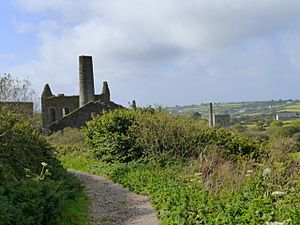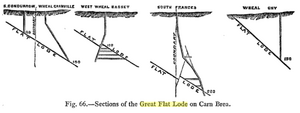Great Flat Lode facts for kids
The Great Flat Lode is a special rock formation in west Cornwall, England. It's found under the southern slopes of a hill called Carn Brea, near the town of Camborne. This rock formation is full of valuable minerals.
Mining for Minerals
In mining, a "lode" is a mineral vein. It's like a long crack in the rock that contains valuable metals. The Great Flat Lode got its name because it was unusual. Most mineral veins in Cornwall go almost straight down, at a steep angle. But the Great Flat Lode was much flatter, sloping at only about 10 degrees from the ground.
This gentle slope made it easier for miners to reach the valuable minerals. At first, miners dug for copper ore. But as they dug deeper, they found lots of tin.
Many mines worked on the Great Flat Lode. Some of the important ones included South Condurrow Mine (which later became King Edward Mine and was used by the Camborne School of Mines), Wheal Grenville, South Wheal Frances Mine, and the Bassett Mines. Over time, many of these mines joined together to work more efficiently. They continued to produce minerals until the First World War.
Great Flat Lode Trail
Today, you can explore the area on the Great Flat Lode Trail. This is a circular path about 12 km (7.5 mi) long that goes around Carn Brea. It's one of Cornwall's special Mineral Tramway Trails, which are paths that follow old routes used by miners to transport minerals.




